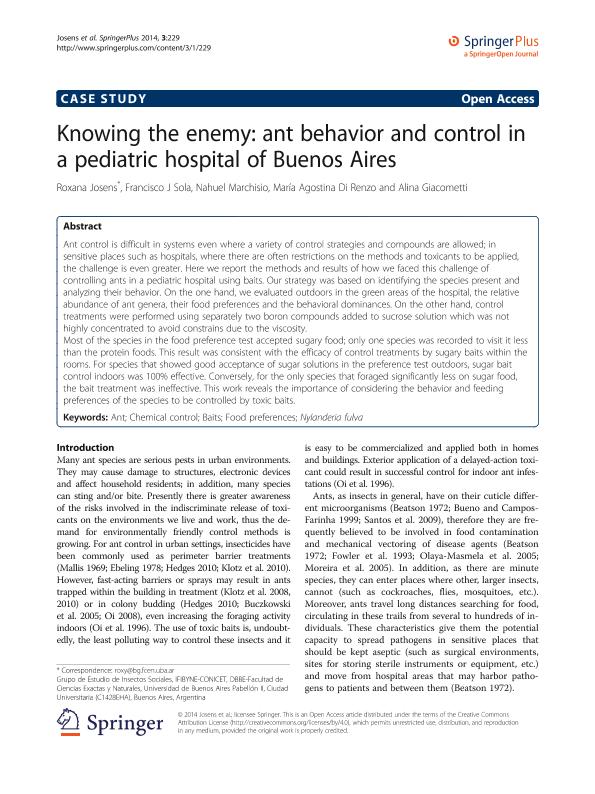Mostrar el registro sencillo del ítem
dc.contributor.author
Josens, Roxana Beatriz

dc.contributor.author
Sola, Francisco Javier

dc.contributor.author
Marchisio, Nahuel Matías

dc.contributor.author
Di Renzo, María Agostina
dc.contributor.author
Giacometti, Alina

dc.date.available
2017-07-11T21:39:24Z
dc.date.issued
2014-04
dc.identifier.citation
Josens, Roxana Beatriz; Sola, Francisco Javier; Marchisio, Nahuel Matías; Di Renzo, María Agostina; Giacometti, Alina; Knowing the enemy: ant behavior and control in a pediatric hospital of Buenos Aires; Springer; SpringerPlus; 3; 229; 4-2014; 1-13
dc.identifier.issn
2193-1801
dc.identifier.uri
http://hdl.handle.net/11336/20200
dc.description.abstract
Ant control is difficult in systems even where a variety of control strategies and compounds are allowed; in sensitive places such as hospitals, where there are often restrictions on the methods and toxicants to be applied, the challenge is even greater. Here we report the methods and results of how we faced this challenge of controlling ants in a pediatric hospital using baits. Our strategy was based on identifying the species present and analyzing their behavior. On the one hand, we evaluated outdoors in the green areas of the hospital, the relative abundance of ant genera, their food preferences and the behavioral dominances. On the other hand, control treatments were performed using separately two boron compounds added to sucrose solution which was not highly concentrated to avoid constrains due to the viscosity. Most of the species in the food preference test accepted sugary food; only one species was recorded to visit it less than the protein foods. This result was consistent with the efficacy of control treatments by sugary baits within the rooms. For species that showed good acceptance of sugar solutions in the preference test outdoors, sugar bait control indoors was 100& effective. Conversely, for the only species that foraged significantly less on sugar food, the bait treatment was ineffective. This work reveals the importance of considering the behavior and feeding preferences of the species to be controlled by toxic baits.
dc.format
application/pdf
dc.language.iso
eng
dc.publisher
Springer

dc.rights
info:eu-repo/semantics/openAccess
dc.rights.uri
https://creativecommons.org/licenses/by-nc-sa/2.5/ar/
dc.subject
Ant
dc.subject
Chemical Control
dc.subject
Baits
dc.subject
Food Preferences
dc.subject
Nylanderia Fulva
dc.subject.classification
Salud Pública y Medioambiental

dc.subject.classification
Ciencias de la Salud

dc.subject.classification
CIENCIAS MÉDICAS Y DE LA SALUD

dc.subject.classification
Zoología, Ornitología, Entomología, Etología

dc.subject.classification
Ciencias Biológicas

dc.subject.classification
CIENCIAS NATURALES Y EXACTAS

dc.title
Knowing the enemy: ant behavior and control in a pediatric hospital of Buenos Aires
dc.type
info:eu-repo/semantics/article
dc.type
info:ar-repo/semantics/artículo
dc.type
info:eu-repo/semantics/publishedVersion
dc.date.updated
2017-07-11T19:27:21Z
dc.journal.volume
3
dc.journal.number
229
dc.journal.pagination
1-13
dc.journal.pais
Reino Unido

dc.description.fil
Fil: Josens, Roxana Beatriz. Consejo Nacional de Investigaciones Científicas y Técnicas. Oficina de Coordinación Administrativa Ciudad Universitaria. Instituto de Fisiología, Biología Molecular y Neurociencias. Universidad de Buenos Aires. Facultad de Ciencias Exactas y Naturales. Instituto de Fisiología, Biología Molecular y Neurociencias; Argentina
dc.description.fil
Fil: Sola, Francisco Javier. Consejo Nacional de Investigaciones Científicas y Técnicas. Oficina de Coordinación Administrativa Ciudad Universitaria. Instituto de Fisiología, Biología Molecular y Neurociencias. Universidad de Buenos Aires. Facultad de Ciencias Exactas y Naturales. Instituto de Fisiología, Biología Molecular y Neurociencias; Argentina
dc.description.fil
Fil: Marchisio, Nahuel Matías. Consejo Nacional de Investigaciones Científicas y Técnicas. Oficina de Coordinación Administrativa Ciudad Universitaria. Instituto de Fisiología, Biología Molecular y Neurociencias. Universidad de Buenos Aires. Facultad de Ciencias Exactas y Naturales. Instituto de Fisiología, Biología Molecular y Neurociencias; Argentina
dc.description.fil
Fil: Di Renzo, María Agostina. Universidad de Buenos Aires. Facultad de Ciencias Exactas y Naturales. Departamento de Biodiversidad y Biología Experimental. Laboratorio del Grupo de Estudio de Insectos Sociales; Argentina
dc.description.fil
Fil: Giacometti, Alina. Consejo Nacional de Investigaciones Científicas y Técnicas. Oficina de Coordinación Administrativa Ciudad Universitaria. Instituto de Fisiología, Biología Molecular y Neurociencias. Universidad de Buenos Aires. Facultad de Ciencias Exactas y Naturales. Instituto de Fisiología, Biología Molecular y Neurociencias; Argentina
dc.journal.title
SpringerPlus
dc.relation.alternativeid
info:eu-repo/semantics/altIdentifier/doi/http://dx.doi.org/10.1186/2193-1801-3-229
dc.relation.alternativeid
info:eu-repo/semantics/altIdentifier/url/https://springerplus.springeropen.com/articles/10.1186/2193-1801-3-229
Archivos asociados
